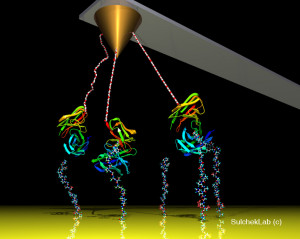We would like to understand bonding across many scales. In the reductionist approach of science, we study the simplest form of biological interaction–the single bond. To gain some understanding in larger scale interactions (e.g. cell-cell adhesion), we design and study simple biological systems that are increasingly more complex than single molecule binding. We have previously shown that multivalent binding , the simultaneous interaction of multiple ligands with multiple receptors, dramatically increases the timescale of adhesion. We have also observed intermediate binding states through force spectroscopy. Currently, we are examining multivalent biological bonds used in the immune systems of organisms.
Multivalent binding impacts every field that intersects with biology and presents an intriguing question: why have researchers shown such a wide a range of multivalent affinity increase, from 101-1010 fold? We will test the hypothesis that multivalent bonds dramatically increase binding strength through a decrease in dissociation kinetics and that the kinetics of dissociation are radically controlled by adjusting the physical properties of the linker between multiple antigen binding sites. The fundamental understanding of biomolecular adhesion at micro- and nano-interfaces may improve sensor functionalization by identifying design principles for highly efficient multivalent binding.

